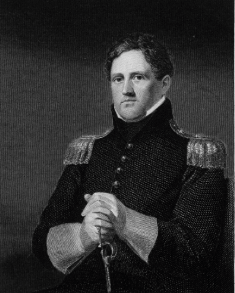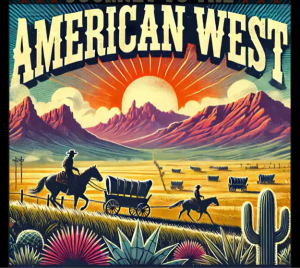A fan of ornate uniforms, supporter of strict military regulations, and a common partaker in quarrels with superiors, General Winfield Scott earned the name “Old Fuss and Feathers.” But General Winfield Scott was not just a hothead who liked pomp and circumstance. He was a great American general—one of the generals responsible for the American victory in the Mexican-American War (1846-1847). And it is important to note that General Scott’s grandiose demeanor was not always so. He was born into a modest family in Petersburg, Virginia in 1786. It was not until his marriage to Maria Mayo that he began his climb the social ladder. Mayo was a part of an elite family from Richmond, Virginia, where her father was a slaveholder, owner of three houses, and owner of a toll bridge across the James River. After his marriage to Mayo, Scott joined the military in 1808, beginning a fifty-three-year career in the military. Just two years into his military career, he was court-martialed and put on a twelve-month suspension for disrespecting one of his superior officers. However, he made good use of his time.1 In that twelve-month suspension from the military, Winfield Scott studied military history and strategy. By doing this, he laid a solid foundation for what was yet to become his future military career as a general. Once back in the military, the high-point of his career happened during the Mexican-American War, where he led outnumbered American troops to victory against the Mexican army.2
The Mexican-American War occurred for various reasons. Some of the reasons for the start of the war include the annexation of Texas in 1845, dispute over the Texas border (whether the border would be the Nueces River or the Rio Grande), and President Polk’s westward expansionist interests, primarily concerning the acquisition of California.3

Even though General Scott proved to be a great general in the Mexican-American War, that did not mean that he necessarily supported the war. He often referred to the war as “Mr. Polk’s War,”4 and he delicately tried to state his opinion about the matter: “Hostilities with Mexico, might, perhaps have been avoided; but Texas lay between—or rather in the scale of war.” Despite his reservations towards the war, he still led one of the most successful campaigns. Scott’s opinion about his own campaign was that “…[it was] executed with impartial rigor, gave the highest moral deportment, and discipline ever known in an invading army.”5
Originally, President Polk’s strategy for the war was to defend Texas and to strike an attack on the Northern frontier of Mexico, which would be led by General Zachary Taylor. General Taylor found himself in a stalemate situation, and that is when Polk sent General Scott to summit an attack starting at the port of Veracruz, which would continue inward to Mexico City. In March of 1847, General Winfield Scott invaded Veracruz. Upon their arrival to Veracruz, Scott stated, “…we did not doubt meeting at our landing the most formidable struggle of the war. No precaution therefore was neglected.”6 The Siege at Veracruz lasted for twelve days until the Mexicans surrendered. After the siege, Scott continued to push westward towards Mexico City.7

One of General Scott’s most impressive battles of the campaign was the Battle of Cerro Gordo. At about sixty-five miles northwest of Veracruz with about 8,500 men, General Scott reached the mountain pass of Cerro Gordo where his forces were up against 12,000 Mexican troops under the command of General Santa Anna, who was sure that General Scott and his men would not be able to pass them while they had the positional advantage. While Cerro Gordo stood at about one-thousand feet, there was a lower hill next to it called La Atalaya, which General Santa Anna deemed to be impassable due to its steep ravines. After being ordered to scout out the terrain, Captain Robert E. Lee and his men found a small pathway up La Atalaya that would allow for an attack on the Mexican troops using a flanking maneuver. It was now planned that the men would attack the Mexican troops from the side using the peak of La Atalaya and from the front, head-on, as well. Because General Santa Anna left La Atalaya unprotected, the American troops were successful.8
The brigade ascended the long and difficult slope of Cerro Gordo, without shelter, and under the tremendous fire of artillery and musketry with the utmost steadiness, reached the breastworks, drove the enemy from them, planted the colors of the 1st artillery, 3d and 7th infantry—the enemy’s flag still flying—and, after some minutes’ sharp firing, finished the conquest with the bayonet.9.
At the Battle of Cerro Gordo, the Mexican troops lost 1,131 men and 3,000 others were taken as prisoners. On the American side, there were 431 casualties.10 After The Battle of Cerro Gordo, General Scott led his troops to victory in other battles including the Battle of Contreras, the Battle of Churubusco, and the Battle of Chapultepec before his arrival in Mexico City. After three days of intense fighting, General Scott captured Mexico City on September 14, 1847. The Treaty of Guadalupe Hidalgo marked the end of the Mexican-American War on February 2, 1848. From this, Mexico agreed to the cession of Arizona, New Mexico, Utah, Colorado, California, Nevada, and Texas (with the border at the Rio Grande and not at the Nueces River). The United States gained all of this for $15,000,000.11

General Winfield Scott, while a brilliant general, owed much of the success he had in the Mexican-American War to his lieutenants. Some of his lieutenants included Robert E. Lee, George B. McClellan, P.G.T Beauregard, and Ulysses S. Grant. 135 of Scott’s men would become generals in their later military careers, 78 of those fighting for the Union forces and 57 fighting for the Confederate forces in the Civil War. The same men that helped each other in the Mexican-American War went on to fight against each other in the American Civil War only 15 years later.4
By 1861, the beginning of the American Civil War, General Scott was 75 years old and he was seen as too old to command the Union forces in the field. General George B. McClellan, who fought with General Scott’s troops during the Mexican-American War in a lower rank, would lead the Union troops instead. Still, Scott would try to help the troops in the Civil War strategically by promoting the so-called Anaconda Plan. His idea was to blockade the Southern ports along the Atlantic and Gulf Coast to strangle the South economically. But this plan required time, and many people did not see the Civil War as lasting that long, and so General Scott’s plan was ridiculed. The Union instead decided to fight the Civil War head-on, which led to the First Battle of Manassas on July 21, 1861. Ironically, after realizing the war would last longer than expected, the wisdom of Scott’s Anaconda Plan became understood, as Lincoln was eager to win the war.13 The American Civil War would not end for another four years, in 1865, with 620,000 deaths.14 There is telling whether General Scott’s plan might have cut the number of casualties down had it been implemented from the beginning of the war.
Scott died on March 29, 1866 in West Point, New York. Before his death, he published a memoir to preserve all the great accomplishments he made as a general in the Mexican-American War and indirectly in the American Civil War.
In December of 1861, President Abraham Lincoln presented General Winfield Scott to the Two Houses of Congress, saying words still relevant today:
During his long life the nation has not been unmindful of his merits; yet in calling to mind how faithfully and ably and brilliantly he has served his country, from a time far back in our history, when few now living had been born, and thenceforward continually—I cannot but think we are still his debtors.15
- Winfield Scott, Memoirs of Lieut.-General Winfield Scott, edited by Timothy D. Johnson (Knoxville: University of Tennessee Press, 2015), xvi. ↵
- Winfield Scott, Memoirs of Lieut.-General Winfield Scott, edited by Timothy D. Johnson (Knoxville: University of Tennessee Press, 2015), xvii. ↵
- Alan Brinkley, American History: Connecting with the Past Volume 1 to 1865 (New York: McGraw-Hill Education, 2011), 357-358. ↵
- Winfield Scott, Memoirs of Lieut.-General Winfield Scott, edited by Timothy D. Johnson (Knoxville: University of Tennessee Press, 2015), xviii. ↵
- Winfield Scott, Memoirs of Lieut.-General Winfield Scott, edited by Timothy D. Johnson (Knoxville: University of Tennessee Press, 2015), 206. ↵
- Winfield Scott, Memoirs of Lieut.-General Winfield Scott, edited by Timothy D. Johnson (Knoxville: University of Tennessee Press, 2015), 210. ↵
- New Encyclopedia, s.v. “Mexican American War.” ↵
- Ulysses S. Grant, “March to Jalapa—Battle of Cerro Gordo—Perote—Puebla—Scott and Taylor,” Personal Memoirs, http://www.latinamericanstudies.org/cerro-gordo/cerro-gordo-grant.htm (accessed December 3, 2016). ↵
- General Winfield Scott, at Plan del Rio, Mexico, to William L. Marcy, Secretary of War, at Washington, D.C. Dispatch communicating Scott’s official report of the Battle of Cerro Gordo (April 19, 1847) ↵
- Encyclopedia Britanica, s.v. “Battle of Cerro Gordo.” ↵
- National Archives, “The Treaty of Guadalupe” https://www.archives.gov/education/lessons/guadalupe-hidalgo (accessed December 3, 2016). ↵
- Winfield Scott, Memoirs of Lieut.-General Winfield Scott, edited by Timothy D. Johnson (Knoxville: University of Tennessee Press, 2015), xviii. ↵
- Encyclopedia Virginia, s.v. “Anaconda Plan,” by Brendan Wolfe. ↵
- National Park Service, “Civil War: Facts,” https://www.nps.gov/civilwar/facts.htm (accessed December 3, 2016). ↵
- Winfield Scott, Memoirs of Lieut.-General Winfield Scott, edited by Timothy D. Johnson (Knoxville: University of Tennessee Press, 2015), 317. ↵



23 comments
Bernie Cyrus
Despite his Southern origins, Scott opposed secession. But if he supported Lincoln’s war and even is credited with devising the infamous Anaconda Plan which according to International Law was a crime because it was starving his own people then he is a shameful example of how military prowess can be also be used wrongly. By the way when Lincoln ordered the Blockade, Virginia Scott’s own state along with North Carolina had not even seceded yet. He did say Robert E. Lee was a “military genius ” but unlike Lee he turned on his own people. By the time the first fighting began, Scott was in very poor health. He was 75 years old, had ballooned to more than 300 pounds and had to be carried about on a door. Too much feasting on the southern fried chicken ? Maybe that’s why he ran afowl !
Oscar Ortega
Much of American Military history before 1900 is often sparsely known, aside from the American Civil War. For example, though you may know that The Mexican-American War happened, oftentimes specifics such as who was involved or their roles, large or small, are often obscure pieces of information. For this reason, I did not remember General Winfield Scott or his contributions to the Mexican American War, or even his Anaconda Plan of the Civil War, and that is a shame. Many men such as Gen. Scott are almost lost from many minds, but their contributions throughout history are responsible for us being where we are as a country today than we’re even often aware. This is a very informative article and it tells one story, likely one of many, of Winfield Scott, a General who, as the article says, ably and brilliantly served his country.
Peter Coons
Prior to reading this article, I had known little about Winfield Scott, save for his Anaconda Plan that was touched on in my high school civil war class. The fact that so many under his command would go on to be military leaders later in their own careers is a testament to his leadership and how he molded the men in his charge. Even more impressive was his ability to thwart Santa Anna when he held an overwhelming tactical advantage. A great article on a great American general.
Dylan Coons
I never heard of General Scott before this. Although that really isn’t surprising since I know literally nothing on military history. Regardless, The article was great and very informative. I learned a great deal of information on the General, including his interesting early career. Especially after reading he was suspended very early on. I’m glad I had a chance to read it!
Auroara-Juhl Nikkels
I did not know much about General Winfield Scott before reading your article, I do not think that I had even heard his name before your article. However, I had heard of the Anaconda Plan. It was surprising to learn that it came come General Scott. I was surprised to learn how much of his life he gave to the military. Very good article!
Aaiyanna Johnson
I have never heard of General Scott. I have however, heard of the Mexican-American war. It is interesting to finally know the General behind this pursuit. He seemed to be a very formidable force, who stood behind what he believed in. I liked your point about the same generals who came together the Mexican-American war, would fight against each other.
Tyler Sleeter
Great article, very informative. It is interesting to me that a man could give 53 years of his life to the military. I do not think that would be allowed in this day and age of forced retirements. I had heard of the Anaconda Plan during the Civil War, but did not know that it had come from General Scott. I did not know much about General Scott before reading this article. He seems like a man that always put his country first even if he did not agree with the activities or the job he was being required to perform.
Sergio Cervantes
A fascinating article over the life of a great American general! To start it off, the fact that he dedicated fifty three years of his life to our nation’s military is amazing and shows the type of man he was. It is interesting to read about the tactics he employed during battle to defeat the enemy. I never knew Winfield Scott created a plan for the Union during the civil war to strangle the South’s economy that would lead an end to it. It proves that even as an old man, he still had a little left inside of him to continue the fight.
Cameron Mays
This article was well-researched, and because it talked about war and great general of the past, it goes right down mine and probably a bunch of guy’s alleys as being quite interesting. Most articles I’ve read recently seemed to be conveyed in a bad way, like the sentence structuring and overall essay structure was just quite poor, but I didn’t really feel that way with this article. Good Job.
Sam Vandenbrink
Very good article on General Scott, we forget about our past military heroes sometimes and this was a great article to make me think about them again. The article did a great job of relaying General Scots whole military carreer. and outlined his success in a way that made sense. He was 75 years old when the civil war started and counldnt lead the troops anymore. But with a military strategist who had so much experience I’m sure they could have used him!